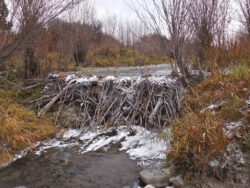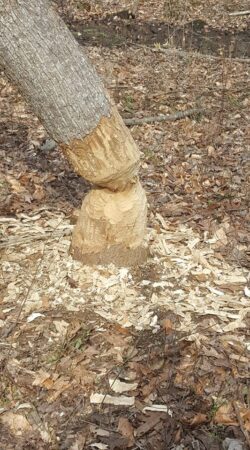It was Beaver that brought Mountain Men to Montana. Europeans wanted hats made of their fur. A prime plume was worth a lot of money in those days. It was amazing that a beaver pelt, caught in Montana’s rivers would travel back to Europe to make a hat! These hats were durable, waterproof, and beautiful. Other garments and designer wear also could be made from these amazing pelts. 
Indians used the waterproof pelts as diapers for their infants. Shove in some cattail plumes and babies were pampered. These critters were also delicious to eat. Mountain Men loved the paddle shaped tails grilled over a fire. These tails could also make a fine hat brim.
Native peoples and early pioneers bartered in beaver and other furs for years. They got to eat the meat and trade for other things that they needed. Bales of beaver skins could be carried, packed, floated, wagoned, and shipped.
For some people, Beavers are a nuisance rodent. They dam up watersheds and create marshes and swamps. Streamside trees are felled and eaten. Their waste pollutes the water and causes Beaver Fever. What possible good are dam building beavers? 
For years, Biologists have studied the value of these eager bark busting beavers. What they have learned has shown just how important beavers are to our ecosystems. These nuisance dams, marshes, and wetlands store water year around. These wetlands now become home for waterfowl, fish, birds, insects, and all types of wildlife. In dry areas, beaver ponds may contain the only water for miles around.
Buying into Beavers may take some education. These Beaver non-believers need to consider the positive impacts of these dam builders. Stream systems that contain beaver ponds buffer the impacts of development and climate change. Beaver engineered projects reduce downstream flooding, recharge aquifers, create habitat, and filter pollution. Beaver dam structures stores water, even during a drought.
The dam building rodents are more efficient and cheaper than bulldozers, concrete, and contractors. Taking a bite out of pollution is also a bonus benefit. Surprisingly, fish can easily find a way through the natural beaver dams. Water tends to open interior channels allowing fish to navigate.
When Beavers were first discovered, their populations were 10-75 chewers per square mile. North America was home to over 400 million tree chewers and pond builders. That’s a lot of hats! When these beavers were trapped and killed, their dams went with them. Suddenly flooding, siltation, and drought became a problem. All wildlife and people suffered.
Stream valleys that were once a web of small channels, grasses, trees, and diverse plants and critters dried up. Nature knows best but humans often think they know better.
Beaver dams improve water quality. When compared to undammed watersheds, beaver dams reduce nitrogen by 18%, phosphorus by 21%, and sediments by 27%. These numbers are better than almost any manmade dams and they do it for free.
Keeping water on the landscape is always important. No water, no life. Natures dam builders engineer dams perfectly to fit the environment. Once established, they can last for generations. Stream restoration costs about $500 a foot. Beavers are way cheaper and create a more natural solution.
Beaver work crews may take a few years to restore watersheds, but in the end, these natural dams offer more good than bad. Long lost habitats can be restored by dam builders with buck teeth. Remote and wilderness dam sites are best. You may not want beavers in your back yard. Beavers are a symbol of clean water and healthy habitats.
Just boil the beaver water before you drink it! 
Montana Grant